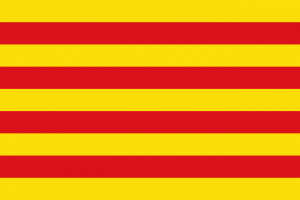Language/Catalan/Culture/The-geography-and-history-of-Catalonia
As a Catalan language teacher with 20 years of experience, I always tell my students that learning about the culture of a language helps them understand the language better. In this lesson, we will explore the geography and history of Catalonia, a fascinating region in the northeast of Spain.
Geography of Catalonia
Catalonia is an autonomous region in northeastern Spain with four provinces: Barcelona, Girona, Lleida, and Tarragona. Its capital is Barcelona, one of the most visited cities in the world because of its culture, architecture, and Mediterranean climate.
Catalonia has a diverse landscape, including high mountains (the Pyrenees) to the north, a coastal plain to the east, and the Ebro river valley to the west. Catalonia has a long coastline with the Costa Brava, a frequently visited area by tourists.
History of Catalonia
Catalan history is a vibrant and complex tapestry that flows through centuries of both unity and division. Here are some important facts about the history of Catalonia:
- Catalonia was originally part of the Roman Empire until the 5th century when the Visigoths overthrew the Roman power.
- From the 8th to the 11th centuries Catalonia was a part of the Arab Empire.
- In the 11th century, Catalonia became an independent county under the rule of Count Ramon Berenguer I.
- In the 13th century, Catalonia became a principality within the Crown of Aragon, with its own parliament and laws.
- From the 15th to the 18th century, Catalonia experienced a Golden Age of art, culture, and trade.
- In 1714, Catalonia lost its autonomy and became a part of the Kingdom of Spain.
- In the 20th century, Catalonia played a significant role in the cultural, social and political life of Spain, with its own language and traditions.
Today, Catalonia is a rich and diverse region with its own distinct identity, culture, language, and history. Many people in Catalonia are passionate about protecting and promoting their unique heritage, including the Catalan language and traditions.
Landmarks of Catalonia
Catalonia is full of incredible landmarks that are worth exploring. Here are some of the most notable ones:
- Sagrada Familia, an amazing basilica designed by the famous architect Antoni Gaudí.
- Park Güell, a unique public park with fascinating sculptures and beautiful architecture by Gaudi.
- Montserrat, a uniquely beautiful mountain range with a Benedictine monastery located at the top.
- The Gothic Quarter, one of the most charming areas of Barcelona, with narrow streets, old buildings, and many beautiful squares.
- Dalí Theatre-Museum, a museum dedicated to one of the most influential painters of the 20th century, Salvador Dalí.
- The Costa Brava, a picturesque coastal area and one of the most popular tourist destinations in Catalonia.
Catalan language and culture
Catalonia has a rich and unique culture, including art, literature, music, and gastronomy. The Catalan language is one of the most important pillars of Catalan culture. It has influenced the region's history, identity, and traditions for centuries. Catalan is a Romance language that is spoken by about 9 million people around the world.
Here are some interesting facts about Catalan culture:
- Catalan cuisine is a perfect mix of Mediterranean and mountain fare, with dishes like pa amb tomàquet, escudella i carn d'olla, and crema catalana.
- Castells, or human towers, are part of the cultural heritage of Catalonia, and are a popular and unique Catalan tradition.
- Sardanes is a traditional Catalan dance that is danced in circles around a band. It has become a symbol of Catalan identity and a method of socialization in Catalonia.
- Modernism is an artistic movement that originated in Catalonia and spread throughout Europe. Antoni Gaudí is the most representative figure of this style, which is characterized by complex shapes, innovative designs, and the use of natural forms.
Learning the history and culture of Catalonia can be an enriching experience that will help you connect more deeply with the Catalan language. In future lessons, we will explore other aspects of Catalan culture, including festivals, traditions, and gastronomy.
| Catalan | Pronunciation | English |
|---|---|---|
| Catalunya | kətuˈɫuɲə | Catalonia |
| Pirineus | piɾiˈnɛws | Pyrenees |
| Ramon Berenguer I | rəˈmom bəɾəŋˈɡewr | Ramon Berenguer I |
| Sagrada Familia | səˈɣɾaðə fəmiˈɫi.ə | Holy Family |
| Park Güell | ˈparɡ ˈɡweʎ | Park Güell |
| Montserrat | munsəˈrat | Montserrat |
| Gothic Quarter | ˈɡɔθik ˈkwɔrtər | Gothic Quarter |
| Dalí Theatre-Museum | dəˈɫi θɛətɾə muˈzɛum | Dalí Theatre-Museum |
| Pa amb tomàquet | pə ˈam tu.məˈkɛt | Bread with tomato |
| Escudella i carn d'olla | əskuˈðeʎə i ˈkaɾn ˈdɔʎə | Catalan Stew |
| Crema catalana | ˈkɾɛmə kətəˈɫanə | Catalan Cream |
Related Lessons
- Catalan identity and linguistic activism
- Catalan cuisine and gastronomy
- Catalan celebrations, traditions and customs
- Major writers, poets, and literary works
- Modern Catalan history and politics
- Catalan cinema and popular culture
- Major artists, architects, and musicians
- Artistic movements and traditions in Catalonia
- Andorra History

